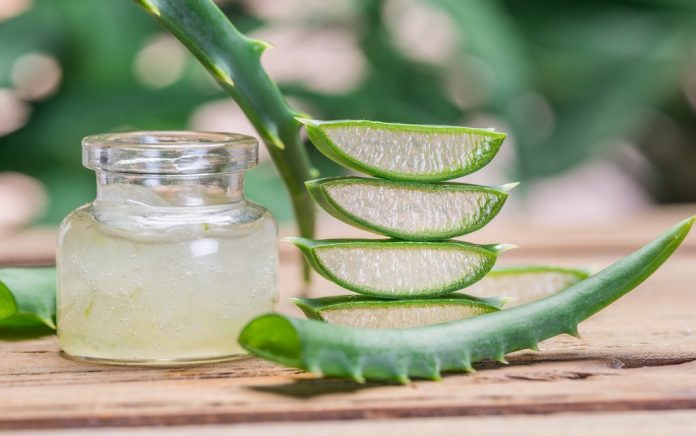
You’ve probably heard a lot about the health benefits of aloe vera (Aloe barbadensis), the succulent many people keep in their kitchen, but it’s buyer beware when it comes to buying and using aloe vera products. You see, unlike the leaves of the plant, which give us 100 percent aloe vera when we snap the plump leaf, you often get much more than you bargained for when buying aloe vera products.
Read about 7 science-based reasons to use aloe vera
What’s in all-natural aloe vera?
The aloe vera plant, which derives from the Arabic word “Alloeh” (“shining bitter substance) and the Latin “vera” (“true”) is truly a botanical and healing wonder. It contains 75 “potentially active constituents,” including:
- Vitamins: A, C, and E, which are antioxidants; plus B12, folic acid, and choline
- Enzymes: Eight, which help reduce inflammation and breakdown sugars and fats
- Minerals: calcium, chromium, copper, selenium, magnesium, manganese, potassium, sodium, and zinc, which are necessary for the proper functioning of enzymes and some antioxidants
- Sugars: Glucose, fructose, glucomannans/polymannose, with some anti-inflammatory and antiallergic properties
- Anthraquinones: Twelve, which act as analgesics, antibacterials, antivirals, and laxatives
- Fatty acids: Four plant steroids, which have anti-inflammatory, antiseptic and analgesic properties
- Hormones: Both auxins and gibberllins fight inflammation and help with wound healing
- Others: Aloe vera contains 20 of the 22 amino acids people require and 7 of the 8 essential amino acids. Other constituents include saponins (antiseptic properties), salicylic acid (anti-inflammatory, antibacterial), and lignin (improves skin penetration).
When buying aloe vera products, you definitely want those that provide the best the plant can offer and avoid any added ingredients that can dilute or take away from these all-natural ingredients. Yet many aloe vera products on the market are delivering more than the real thing.
What’s in aloe vera products?
Let’s take a look at the options on the shelves. First of all, you should be cautious when reading the front of the packaging. Does it say “100% pure aloe vera” or “made with 100% pure aloe vera”?
The first phrase means you are getting 100% pure aloe vera, but the second one is misleading. Producers can legally use that phrase and give you a product that contains a lot of water and just a small amount of 100% pure aloe vera. Check out the ingredient panel and see what is listed. Is the first ingredient water or aloe vera?
Compare these two aloe vera products. They are both for an aloe vera gel:
- Product #1: Certified organic aloe vera (99.75%), citric acid, potassium sorbate, xanthan.
- Product #2: Water, denatured alcohol, glycerin, polysorbate 20, carbomer, triethanolamine PEG-4 dilaurate, PEG-4 laurate, aloe barbadensis leaf juice, PEG-4, benzophenone-4, imidazolidinyl urea, iodopropynyl butylcarbamate, fragrance, yellow 5, blue 1.
Did you find the aloe vera in the second product? The front of the second product says “with pure aloe vera,” and that is true. However, it comes with a full cast of other ingredients, several of which are not considered to be healthy, including polysorbate 20, the PEG ingredients, iodopropynyl butylcarbamate, fragrance, yellow 5, and blue 1.
Read about how to shop for aloe vera
How to buy aloe vera products
Here are some tips for buying aloe vera products:
- Always look for certified organic products.
- Buy cold-pressed aloe vera when possible, since this retains the essential nutrients in the product
- Read the ingredient label carefully. Aloe vera should be the first ingredient. Period.
- Check for acceptable additional ingredients. Depending on the type of aloe vera products you are buying, you may find water, grapefruit extract (preservative and healing agent), guar gum, tocopherol (vitamin E), citric acid (preservative), potassium sorbate (preservative to protect against bacteria), ascorbic acid (vitamin C, preservative), xanthan (helps coat the skin better), carbomer (thickening agent), disodium edetate (preservative), sodium hydroxyl methylglycinate (preservative), or comfrey root extract (soothing and healing).
- Look for denatured alcohol. Manufacturers use alcohol to create a cooling effect, which aloe vera has naturally if you keep it in the refrigerator. Alcohol dries out your skin. It is best to avoid it.
- What color is your aloe vera? Natural aloe vera is slightly golden, so the product you buy should be the same. If it is green, then it has been artificially colored.
Bottom line
A growing number of aloe vera products on the market are meeting the demands of consumers for quality. Take a few minutes to read the ingredients labels, follow the tips, and you’ll find the best product for you.
[Editor's Note: Our trusted, go-to brand of aloe vera products is Lily of the Desert. All of their line is organic and the ingredients list for product #1 is theirs. They have both topical gelly and aloe products you can take internally as well.]
Source
Surjushe A et al. Aloe vera: a short review. Indian Journal of Dermatology 2008; 53(4): 163-66





